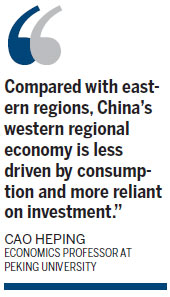Central, west still to face pressure in H2

China's hinterlands experienced relatively faster investment growth in the first half of this year, but analysts said these regions face greater downside pressure than eastern regions during the second half, precisely because their growth relied more on investment.
Fixed-asset investment excluding rural households in China increased 20.1 percent in the first half, the National Bureau of Statistics said Monday.
In central regions, the figure was 23.6 percent, while it was 22.7 percent in western regions and 18.7 in eastern regions.
But investment growth in central and western regions slowed from last year, when it was 24.1 percent for central regions and 23.1 percent for western regions.
"Compared with eastern regions, China's western regional economy is less driven by consumption and more reliant on investment.
"Thus, it faces more pressure to prop up growth as the central government, determined to rebalance the economy toward consumption, will be more reluctant to approve" projects in the west, said Cao Heping, an economics professor at Peking University.
China's second-quarter GDP growth, at 7.5 percent, fell within the market's expected range. This may strengthen the central government's resolve to refrain from stepping in with a stimulus package as it did in the past, Cao said.
Last week, Minister of Finance Lou Jiwei signaled China's greater tolerance of an economic slowdown, saying GDP growth this year is expected to be 7 percent.
The economy expanded 7.8 percent in 2012 and the government originally set a target of 7.5 percent for this year.
"Structural adjustment is a painful thing," Lou said on the sidelines of the fifth U.S.-China Strategic and Economic Dialogue in Washington.
"It's impossible to adjust structures if you still want to feel very comfortable and maintain a very high growth rate."
Last month, President Xi Jinping said local government officials should not be judged solely on their record in boosting GDP but also by their progress in improving living standards, social development and environmental quality.
"Local governments in hinterland regions should not expect a large stimulus package any more, because the broader economic environment now does not support this," said Feng Qiaobin, a professor of public finance at the Chinese Academy of Governance.
Hinterland areas should not pin too much hope on foreign direct investment either, because general FDI growth in China is also slowing , according to Feng.
"They might have an edge in cost, but they are not competitive in other sectors such as location and business efficiency. If you just compare costs, Southeast Asian countries are more competitive," she said.
Actual FDI from January to May rose 1.03 percent from a year earlier, according to the Ministry of Commerce.
FDI in western regions posted 22.54 percent growth, much faster than the rates for the central or eastern regions. But the amount, at $3.74 billion, only accounted for 7.86 percent of the nation's total.
Hu Xiaodeng, a researcher with the Guizhou provincial Chinese Academy of Social Sciences, however, urged the central government to support many of the unfinished projects at the local level.
"If you jam on the brakes too fast, you risk ending up with many half-built projects, which is a waste of resources," he said.
He added that many measures adopted by Beijing to rein in sectors with excess capacity had made no distinction between the eastern and western regions, which was a bit "unfair" to western regions.
"Many projects, which might be overbuilt in eastern regions, might just take off in western regions," he said.
Projects that are still needed in the hinterlands include urban infrastructure, inter-city transportation and information and communications technology, Feng said.

























